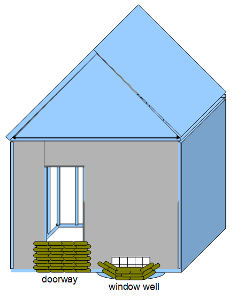Tags | |
The Sandbag Wall (1 bag deep) calculator computes the number of sandbags and sand needed for a sandbag wall that is (H) high and (L) long where the width of the wall is equivalent to the width of one sandbag (see diagram).  Water Barriers Sandbag Walls
Water Barriers Sandbag Walls
INSTRUCTIONS: Choose units and enter the following:
- (H) Height of Wall
- (L) Length of Wall
Sandbags (SB): The calculator computes the number of Sandbags Needed for a 1 bag deep wall as shown in the diagram and the volume of sand in cubic yards.
The Math / Science
Sandbag Walls
This simple act of flooding prevention has saved thousands of dollars from water damage through doorways, stairwells and low-lying windows. Sandbag walls that are one bag deep can be useful in for protection from some projectiles and from some water threats. However, in the even of rising water in creeks and storm surges, the user should consider a sandbag dike if the height is expected to exceed two feet or strong currents pressing against the wall. For a more substantial wall (dike), consider the Sandbag Dike Formula (HERE) or the combined functions in the Sandbag Dike Calculator (HERE).
Filling Sandbags
It is best to partially fill the sandbags. The recommendation is for one third (`1/3`) to half (`1/2`) full with the bag tied off at the neck. This lets the bag be more pliable (flexible) in the stacking process compacting the space between bags. It also makes the bag more manageable to handle.
Stacking Sandbags
Lay your sandbags one layer at a time in tight formation. On subsequent layers, offset the bags in a way that staggers the vertical seems. This is similar to the process that bricklayers employee when stacking bricks. It creates a stronger wall.
Preparing the site
Obviously, a sandbag wall is heavy. Consider this when placing the wall. Also, for water protection, it is also advised to wrap your wall in plastic sheets (normal construction plastic). This improves the walls properties for holding out water.
Where to use
Small walls (1 bag deep) can be used in long rows to prevent surface water movement. As stated above, if water prevention is the primary purpose, the weight (and force) of the moving water are a serious consideration. If the expected level of water rises is above two feet (one foot for fast moving water), a dike is more advisable.
Sandbag walls are also useful around window wells, basement steps, and in ground-level doorways.
Sandbag Wall Calculators
- Sand and Sandbags for a Dike (3x1) - This calculates the number of sandbags and volume of sand needed for a 3x1 depth to height ratio sandbag dike.
- Width of Sandbag Dike Base - Compute the width and number of bags for the cross-section base of a 3x1 sandbag dike.
- Sand for a Dike - This calculates the volume of sand needed for a flood prevention dike.
- Sandbags in a Wall - This calculates the number of sandbags needed for a wall that is only one bag thick.
- Sand Required for a Wall- This calculates the approximate amount of sand needed for a one bag thick wall.
- Time to Fill the Sandbags - This calculates the approximate amount of time to fill a number of sandbags.
- Weight of Sandbags - This calculates the load weight of a number of filled sandbags.
- Weight of Sand - This calculates the approximate weight of a volume of sand (wet, dry, loose or packed)
- Price of Sand - Computes total cost of a volume of sand based on the price per ton.
Where can I buy sandbags?
- AceHardware
- Quik-Response self-expanding sandbags
- Sandbagstore
- uline.com
- esandbags.com
- HomeDepot
- Sandbag Express
- Sandbaggy
The above are a sample of places to buy sandbags for flood prevention.

